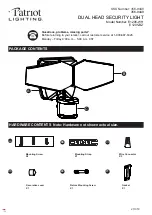
Caution
•
All wiring MUST comply with local
electrical codes and should be installed
by qualified electrician.
•
Read entire Installation Manual before
proceeding.
TURN OFF POWER BY REMOVING
POWER FUSE OR TURNING OFF CIRCUIT
BREAKER BEFORE INSTALLATION.
• Total lighting load must not exceed:
5 Amps, 500 Watts incandescent quartz
when sensor is used remotely (250 Watts
when floodlights are mounted to sensor)
or 100 Watt fluorescent at 120 Volts or 5
Amps, 450 Watts LED at 120 Volts with
0.8pF driver or 5 Amp, 300 Watts LED
at 120 Volts with 0.5pF driver. To switch
more wattage, an electrician can install
an additional relay.
• Line Carrier Remote Control Systems
such as X-10, Leviton or Radio Shack are
incompatible with sensors and cause
false activations.
• Do not install on circuits feeding motor
loads such as kitchen appliances, HVAC
equipment, washer/ dryer or garage door
openers.
• Sensor functions best when movement is
across its detection pattern, not towards
the sensor.
• Mount 6’-10’ high for optimum range and
direction.
Less Sensitive
More Sensitive
Assembly and Wiring
1.
Screw the threaded arm of the sensor
into the center hold of the mounting
plate. Sensors can be wall or ceiling
mounted.
2.
If mounting on the same cover plate
as floodlight(s), screw the threaded
arm(s) of each floodlight into the
mounting plate. Leave the locknuts
and arm screws loose untill ready to
aim. Always mount the sensor below
lights.
3.
Bring power leads and sensor leads
into box.
4.
Attach ground wire(s) to outlet box
grounding screw.
5.
Strip 1/2” of insulation from all leads.
Connect as shown in Wiring Diagram.
6.
Twist on wire nuts. Secure with
electrical tape.
7.
Align gasket to ensure proper seal.
Fasten mounting plate with sensor
with two screws provided. Use
silicone sealant around all openings, if
necessary.
8.
Screw in light bulbs. Turn on power.
9.
Conduct Walk Test to adjust sensor
response.
Basic Wiring Diagram
5
4


























